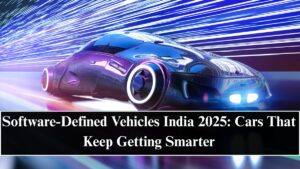The automobile industry in India is undergoing a digital transformation — and Software-Defined Vehicles India 2025 are leading the way. Cars are no longer just mechanical machines; they’re evolving into intelligent, connected platforms that learn, update, and adapt over time. This shift toward software-driven architectures marks a new era of personalization, safety, and connectivity for Indian consumers.

From Hardware to Software: A Paradigm Shift
Traditionally, cars were defined by their hardware — engines, chassis, and transmissions. But in 2025, vehicles are increasingly defined by code and data. With Over-The-Air (OTA) updates, manufacturers can now upgrade a vehicle’s features, fix bugs, or enhance performance remotely, just like a smartphone.
Brands like Tata Motors, Mahindra, Hyundai, and MG are already integrating SDV platforms that allow new functions such as driver assistance, infotainment updates, and enhanced vehicle diagnostics to be activated post-purchase. This represents a major leap from static manufacturing to dynamic, service-based mobility.
The Rise of Connected Car Platforms
The foundation of the SDV India 2025 revolution is connectivity. Cars today are equipped with telematics control units (TCUs) that communicate in real-time with cloud servers, providing data on driving behavior, predictive maintenance, and traffic updates.
These connected car platforms also enable remote monitoring, geofencing, and theft detection, offering unmatched convenience and safety. The Vehicle-to-Everything (V2X) communication infrastructure further ensures seamless interaction between cars, roads, and smart cities, making driving safer and smarter.
OTA Updates and Continuous Improvement
OTA updates vehicles India 2025 have become a defining feature of software-defined mobility. Instead of visiting service centers for minor fixes or upgrades, drivers can now receive updates directly from the manufacturer’s servers. This enables continuous feature expansion — from performance tuning to advanced driver assistance upgrades.
Manufacturers like Mercedes-Benz India and BMW are monetizing OTA upgrades by offering “feature-on-demand” services. For instance, drivers can unlock adaptive cruise control or premium sound features for a monthly fee — a model that’s reshaping post-sale revenue streams for automakers.
Data Ecosystem and AI Integration
At the core of software-defined mobility lies the power of data. Every connected car generates terabytes of real-time data, analyzed using AI and edge computing to enhance efficiency and safety.
For example, vehicle sensors monitor tire pressure, battery performance, and engine health, transmitting data for predictive maintenance. This prevents breakdowns before they occur. AI algorithms can even learn individual driving styles and adjust suspension, throttle, and braking behavior to deliver a personalized experience.
The integration of voice assistants, gesture controls, and AR dashboards further enhances driver engagement, making modern vehicles feel intuitive and futuristic.
Challenges in the Software-Defined Ecosystem
Despite its promise, the rise of software-defined vehicles brings challenges such as cybersecurity risks, software validation complexity, and regulatory compliance. With cars constantly online, protecting them from hacking and data theft is critical.
To address this, India’s upcoming Automotive Cybersecurity Framework under the Ministry of Road Transport and Heavy Industries (MoRTH) aims to standardize data protection and over-the-air security protocols. Collaboration with global tech firms and cloud providers is also increasing to ensure reliable, scalable solutions.
The Road Ahead for SDVs in India
By 2025, most new vehicles in India are expected to have software-driven architectures capable of OTA updates, AI-assisted diagnostics, and cloud connectivity. This shift is not just about smarter cars but about redefining the entire mobility ecosystem — from manufacturing to customer experience.
Automakers are partnering with tech giants such as Bosch, NVIDIA, and Qualcomm to integrate advanced processors and neural networks directly into vehicles. As India accelerates toward autonomous and connected mobility, the software-defined vehicle will be the cornerstone of that transformation.
FAQs
What is a software-defined vehicle (SDV)?
A software-defined vehicle (SDV) is a car where software, not hardware, defines most functionalities. It can be updated or enhanced via over-the-air updates without physical modification.
How are SDVs changing the Indian automotive market?
SDVs are enabling connected, upgradeable cars that can receive new features, safety improvements, and personalization updates throughout their lifecycle.
Which automakers in India are leading the SDV trend?
Manufacturers like Tata Motors, Mahindra, Hyundai, and MG have introduced connected car ecosystems with OTA updates, real-time diagnostics, and AI-powered features.
Are there security concerns with connected cars?
Yes. Cybersecurity is a major concern as cars connect to the internet. India’s automotive cybersecurity regulations are evolving to ensure secure data transmission and user protection.
Will all cars become software-defined by 2030?
While not all vehicles will be fully software-defined by 2030, most mid- to high-end models will integrate software-first architectures with connectivity and cloud-based updates.
Click here to know more.
